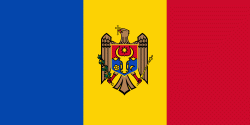Transnistria (Unitatea Teritorială din Stînga Nistrului)
 |
 |
The region's origins can be traced to the Moldavian Autonomous Soviet Socialist Republic, which was formed in 1924 within the Ukrainian SSR. During World War II, the Soviet Union took parts of the Moldavian ASSR, which was dissolved, and of the Kingdom of Romania's Bessarabia to form the Moldavian Soviet Socialist Republic in 1940. The present history of the region dates to 1990, during the dissolution of the Soviet Union, when the Pridnestrovian Moldavian Soviet Socialist Republic was established in hopes that it would remain within the Soviet Union should Moldova seek unification with Romania or independence, the latter occurring in August 1991. Shortly afterwards, a military conflict between the two parties started in March 1992 and concluded with a ceasefire in July that year.
As part of the ceasefire agreement, a three-party (Russia, Moldova, Transnistria) Joint Control Commission supervises the security arrangements in the demilitarised zone, comprising 20 localities on both sides of the river. Although the ceasefire has held, the territory's political status remains unresolved: Transnistria is an unrecognised but de facto independent presidential republic with its own government, parliament, military, police, postal system, currency, and vehicle registration. Its authorities have adopted a constitution, flag, national anthem, and coat of arms. After a 2005 agreement between Moldova and Ukraine, all Transnistrian companies that seek to export goods through the Ukrainian border must be registered with the Moldovan authorities. This agreement was implemented after the European Union Border Assistance Mission to Moldova and Ukraine (EUBAM) took force in 2005. Most Transnistrians have Moldovan citizenship, but many also have Russian, Romanian, or Ukrainian citizenship. The main ethnic groups are Russians, Moldovans/Romanians, and Ukrainians.
Transnistria, along with Abkhazia, South Ossetia, and Artsakh, is a post-Soviet "frozen conflict" zone. These four partially recognised or unrecognised states maintain friendly relations with each other and form the Community for Democracy and Rights of Nations.
The region can also be referred to in English as Trans-Dniester or Transdniestria. These names are adaptations of the Romanian colloquial name of the region, Transnistria, meaning "beyond the Dniester River".
The term Transnistria was used in relation to eastern Moldova for the first time in 1989, in the election slogan of the deputy and member of the Popular Front of Moldova Leonida Lari: "Let my hands be covered in blood up to my elbows, but I will throw out the invaders, aliens and mankurt over the Dniester, I will throw them out of Transnistria, and you, the Romanians, are the real owners of this long-suffering land, you will get their houses, their apartments, along with their furniture... We will make them speak Romanian, respect our language, our culture!"
The documents of the government of Moldova refer to the region as Stînga Nistrului (in full, Unitățile Administrativ-Teritoriale din Stînga Nistrului) meaning "Left Bank of the Dniester" (in full, "Administrative-territorial unit(s) of the Left Bank of the Dniester").
According to the Transnistrian authorities, the name of the state is the "Pridnestrovian Moldavian Republic" (PMR) (Приднестро́вская Молда́вская Респу́блика, ПМР, Pridnestróvskaya Moldávskaya Respúblika; Republica Moldovenească Nistreană, RMN, Moldovan Cyrillic alphabet: Република Молдовеняскэ Нистрянэ, РМН; Придністро́вська Молда́вська Респу́бліка, ПМР, Prydnistróvska Moldávska Respúblika). The short form is Pridnestrovie (Приднестровье, ; Nistrenia, Moldovan Cyrillic alphabet: Нистрения, ; Придністров'я, Prydnistrovia, ), meaning "[land] by the Dniester".
Map - Transnistria (Unitatea Teritorială din Stînga Nistrului)
Map
Country - Moldova
 |
 |
| Flag of Moldova | |
Most of Moldovan territory was a part of the Principality of Moldavia from the 14th century until 1812, when it was ceded to the Russian Empire by the Ottoman Empire (to which Moldavia was a vassal state) and became known as Bessarabia. In 1856, southern Bessarabia was returned to Moldavia, which three years later united with Wallachia to form Romania, but Russian rule was restored over the whole of the region in 1878. During the 1917 Russian Revolution, Bessarabia briefly became an autonomous state within the Russian Republic. In February 1918, it declared independence and then integrated into Romania later that year following a vote of its assembly. The decision was disputed by Soviet Russia, which in 1924 established, within the Ukrainian SSR, a so-called Moldavian autonomous republic on partially Moldovan-inhabited territories to the east of Bessarabia.
Currency / Language
| ISO | Currency | Symbol | Significant figures |
|---|---|---|---|
| MDL | Moldovan leu | L | 2 |
| ISO | Language |
|---|---|
| RO | Romanian language |
| RU | Russian language |
| TR | Turkish language |
















